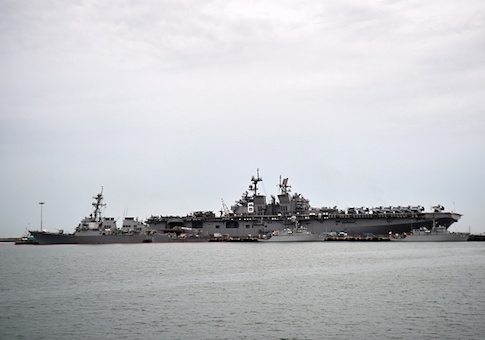The Navy must alter how it deploys ships overseas in the wake of two fatal collisions this year that brought to light severe lapses in training for sailors aboard vessels that had not returned to the United States for maintenance in over a decade, according to the House seapower subcommittee chairman.
Rep. Rob Wittman (R., Va.) said the Navy's reliance on forward-deployed forces that operate abroad for several years at a time is unsustainable. He called on the Navy to reassess its current deployment model to dedicate more time to training and maintenance, which have been respectively shortened and deferred to meet the increased demand for an American military presence in the pacific.
"Training is not up, systems are not up on the ships—whether it's maintenance or time to train—so certification is lapsed, yet ships are still forward deployed," Wittman told the Washington Free Beacon.
"At the same time, we're pushing fewer ships harder, we're pushing fewer sailors harder, with some working 100 hours a week, so they're then taking on more risk because you don't have that full skill set needed to operate safely … and we've seen that risk manifest itself in these collisions."
A U.S. government watchdog testified Thursday that more than a third of Navy ships based in the Pacific region had expired warfare training certifications. Speaking before a House Armed Services Committee panel, Government Accountability Office official John Pendleton said a new report found that 37 percent of the Navy's destroyers and cruisers off of Japan were expired—a 7 percent increase since January 2015.
Wittman said the lapses in certification compromised the Navy's ability to perform basic seamanship skills such as navigation.
"What happens on these ships is they're doing training at sea, which takes time away from what you're actually tasked to do when the ship is operating," Wittman told the Washington Free Beacon. "It's hard to complete as much training as you need while simultaneously operating the ship."
He said maintenance has also been compressed because the Navy has been forced to balance a smaller fleet size with longer and more frequent deployments.
Naval ships are expected to return to the United States for maintenance at least every seven to 10 years, but a report by GAO published Thursday found this target to be largely unobserved.
The USS Fitzgerald was deployed for over 10 years before it collided with a container ship off the coast of Japan and killed seven U.S. sailors on June 17. The USS John McCain, which lost another 10 troops on Aug. 21, had been overseas for more than two decades at the time of its collision.
Wittman said in addition to providing the funding required to expand the Navy's fleet size, Congress must ensure the service has the resources needed to bring its vessels back to the United States every seven to ten years as required to break the cycle of maintenance backlogs.
Even with adequate funding, it will take years for the Navy to rebuild readiness. Wittman said Congress bears part of the blame for readiness gaps given its repeated passage of short-term budget measures like continuing resolutions, but he also laid fault on the Navy. He said senior service officials needs to be able to say "no" to a mission if they feel they have inadequate resources to sustain it.
"I know it is very difficult for the Navy to do that because with every fiber of their being they're about performing the mission and they're about saying, 'yes, we can do this,' and finding ways to do it … but at some point, the Navy has to say 'Hey, these are the things we have to do in order to make sure that we can operate safely,'" he said.
